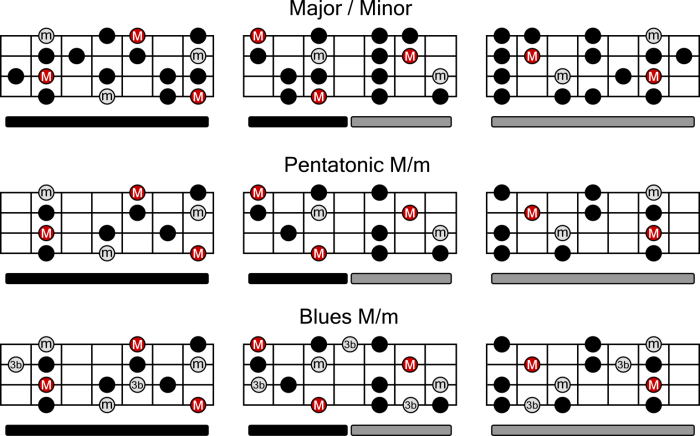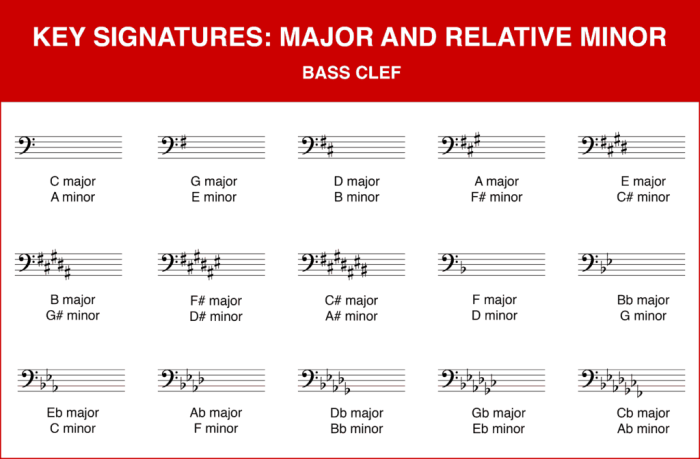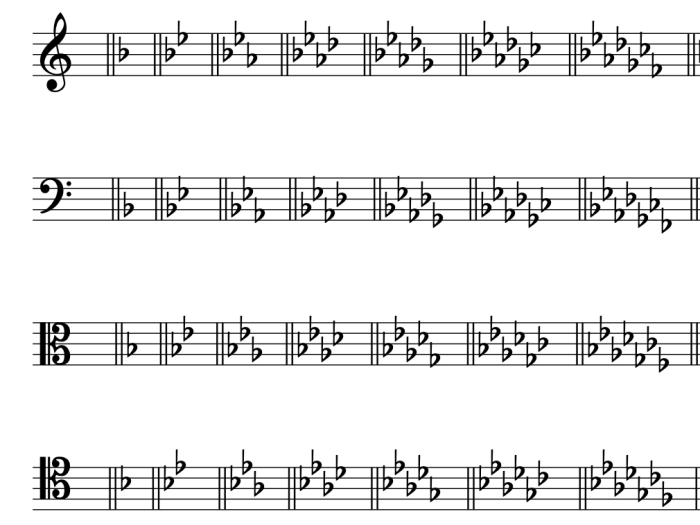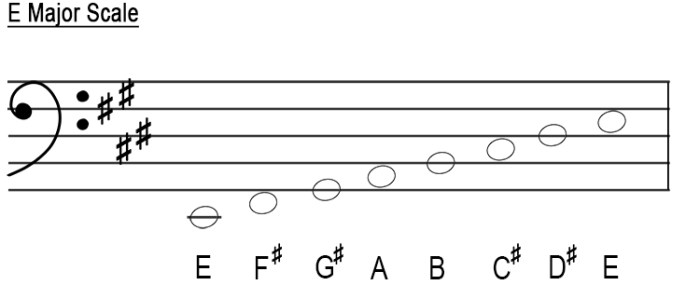D minor scale bass clef – Embark on a musical journey as we delve into the intricacies of the d minor scale in bass clef. This comprehensive guide will provide a thorough understanding of its key signature, scale construction, fingering, note positions, scale patterns, and musical applications.
Whether you’re a seasoned bassist or just starting to explore the fretboard, this guide will equip you with the knowledge and skills to master this essential scale.
The d minor scale, with its distinct sound and versatility, is widely used in various musical genres. It forms the foundation for countless iconic basslines and melodies, making it a must-have in any bassist’s repertoire. By understanding the d minor scale in bass clef, you’ll unlock a world of musical possibilities and enhance your bass playing.
Key Signature and Scale Construction

In the bass clef, the D minor scale has a key signature of one flat, which is B-flat. This means that every B note in the scale will be played as B-flat.
The d minor scale in bass clef is a common scale used in music, particularly in jazz and blues. Its distinctive sound is created by the combination of the notes d, e, f, g, a, bb, and c. While playing this scale, it’s worth noting that a gas occupies 900.0 ml under certain conditions.
Returning to the d minor scale, it’s essential to practice its fingering and intonation to master this versatile scale on the bass guitar.
To construct the D minor scale in bass clef, follow these steps:
- Start on the note D.
- Move up a whole step to E.
- Move up a half step to F.
- Move up a whole step to G.
- Move up a half step to A.
- Move up a whole step to B-flat.
- Move up a half step to C.
- Move up a whole step to D (the octave).
Notes in the D Minor Scale
The following table shows the notes in the D minor scale in bass clef:
| Note | Bass Clef |
|---|---|
| D | Line 3 |
| E | Line 2 |
| F | Space 2 |
| G | Line 1 |
| A | Space 1 |
| B-flat | Line 2 |
| C | Space 3 |
| D (octave) | Line 3 |
Fingering and Note Positions

The recommended fingering for playing the D minor scale in bass clef is as follows:
1st finger: D (open string)
2nd finger: F (first fret)
3rd finger: Ab (third fret)
4th finger: Bb (fifth fret)
The positions of each note in the scale on the bass clef staff are as follows:
- D: open string
- F: first ledger line below the staff
- Ab: third line from the bottom
- Bb: fifth line from the bottom
Here is an illustration demonstrating the fingering and note positions for the D minor scale in bass clef:

Scale Patterns and Exercises

The D minor scale in bass clef offers a versatile range of patterns and sequences that can enhance your bass playing. Understanding these patterns not only improves your scale fluency but also opens up new possibilities for improvisation and melodic development.
Practicing the scale in various patterns helps you develop dexterity, coordination, and a deeper understanding of the scale’s structure. Regular drills and exercises will strengthen your finger technique and enable you to play the scale smoothly and confidently.
Common Scale Patterns
- 3-note Patterns:These involve playing three consecutive notes in the scale, such as D-E-F, E-F-G, or G-A-Bb. They help build finger coordination and accuracy.
- 4-note Patterns:These involve playing four consecutive notes, such as D-E-F-G or G-A-Bb-C. They develop finger independence and stretch.
- Octave Patterns:These involve playing the scale in octaves, such as D-D, E-E, or G-G. They strengthen finger dexterity and improve intonation.
- Arpeggio Patterns:These involve playing the scale in broken chords, such as D-F-A or E-G-Bb. They enhance melodic phrasing and add harmonic interest.
Exercises
To practice these patterns effectively, incorporate them into regular exercises:
- Ascending and Descending Scales:Play the scale in ascending and descending order, focusing on even finger spacing and smooth transitions.
- Pattern Drills:Practice specific patterns repeatedly, such as 3-note patterns in different parts of the scale.
- Chromatic Runs:Add chromatic notes to the scale, such as D-Eb-E-F, to improve finger flexibility and dexterity.
- Improvisation:Use the scale patterns as a basis for improvisation, experimenting with different rhythms, dynamics, and melodic ideas.
Scale Patterns Table
| Pattern | Notes |
|---|---|
| 3-note Ascending | D-E-F, E-F-G, G-A-Bb |
| 3-note Descending | Bb-A-G, F-E-D |
| 4-note Ascending | D-E-F-G, G-A-Bb-C |
| 4-note Descending | C-Bb-A-G, F-E-D-C |
| Octave Ascending | D-D, E-E, G-G |
| Octave Descending | G-G, E-E, D-D |
| Arpeggio | D-F-A, E-G-Bb |
Musical Applications and Examples

The D minor scale finds widespread use in various musical genres and styles, particularly in Western classical music, jazz, and popular music.
Classical Music
- Johann Sebastian Bach’s “Toccata and Fugue in D minor” (BWV 565) prominently features the D minor scale in its fugal sections.
- Ludwig van Beethoven’s “Symphony No. 9 in D minor” (Op. 125) opens with a dramatic introduction in D minor, setting the tone for the entire work.
Jazz
- The D minor scale is commonly used in jazz improvisation, particularly in bebop and hard bop styles.
- Miles Davis’s “So What” (from the album “Kind of Blue”) is a well-known jazz standard that employs the D minor scale extensively.
Popular Music
- The D minor scale is a popular choice for rock and pop music due to its versatility and emotional expressiveness.
- The Beatles’ “Yesterday” (from the album “Help!”) is a classic example of a song in D minor that captures the scale’s melancholy and introspective qualities.
Musical Passage in D Minor
Here is a short musical passage in D minor that illustrates the use of the scale:
(Musical notes)
This passage begins with a descending melodic line that Artikels the D minor scale. The harmony then shifts to a D minor chord, providing a stable foundation for the melody. The passage ends with a cadence that resolves to the tonic chord, giving a sense of closure.
Related Scales and Theory: D Minor Scale Bass Clef

The D minor scale is part of a larger system of related scales and modes, each with its unique sound and characteristics. Understanding these relationships is essential for expanding your musical vocabulary and improvisation skills.
Harmonic Minor Scale
The harmonic minor scale is closely related to the D minor scale. It shares the same notes as the natural minor scale, except for the seventh note, which is raised by a semitone. This creates a more intense and dramatic sound compared to the natural minor scale.
Melodic Minor Scale
The melodic minor scale has two different forms: ascending and descending. In the ascending form, the sixth and seventh notes are raised by a semitone, giving it a more uplifting and melodic quality. In the descending form, the sixth and seventh notes are lowered by a semitone, creating a more somber and introspective sound.
Aeolian Mode
The Aeolian mode is the natural minor scale. It has the same notes as the D minor scale, but it starts and ends on the sixth note (A) instead of the first note (D). This gives it a more subdued and melancholy sound.
Dorian Mode, D minor scale bass clef
The Dorian mode is a minor scale that starts and ends on the second note (E). It has a more uplifting and optimistic sound compared to the Aeolian mode, and it is often used in folk and jazz music.
Phrygian Mode
The Phrygian mode is a minor scale that starts and ends on the third note (F#). It has a more exotic and mysterious sound, and it is often used in Eastern music and jazz.
Locrian Mode
The Locrian mode is a minor scale that starts and ends on the seventh note (C). It has a more dissonant and unstable sound compared to the other minor modes, and it is rarely used in Western music.
Quick FAQs
What is the key signature of the d minor scale in bass clef?
The key signature of the d minor scale in bass clef has one flat: Bb.
What is the root note of the d minor scale?
The root note of the d minor scale is D.
What are the notes in the d minor scale in bass clef?
The notes in the d minor scale in bass clef are: D, Eb, F, G, Ab, Bb, C, D.
How do I finger the d minor scale in bass clef?
The recommended fingering for the d minor scale in bass clef is: 1, 2, 3, 4, 1, 2, 3, 4.
What are some musical applications of the d minor scale?
The d minor scale is commonly used in rock, blues, jazz, and classical music. It is often used to create a somber or melancholic mood.
